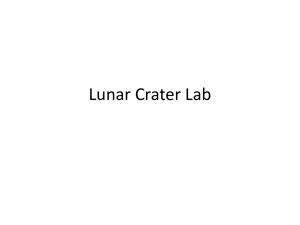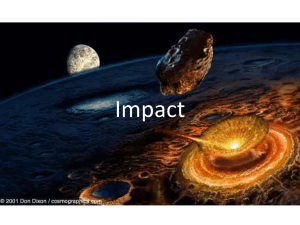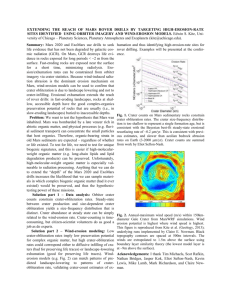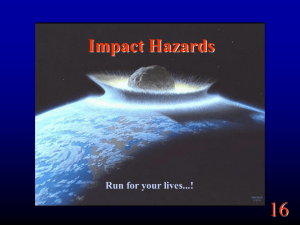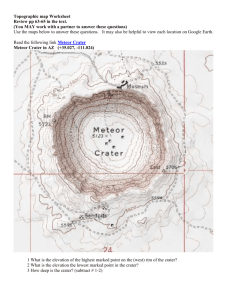Planetary features and processes
advertisement
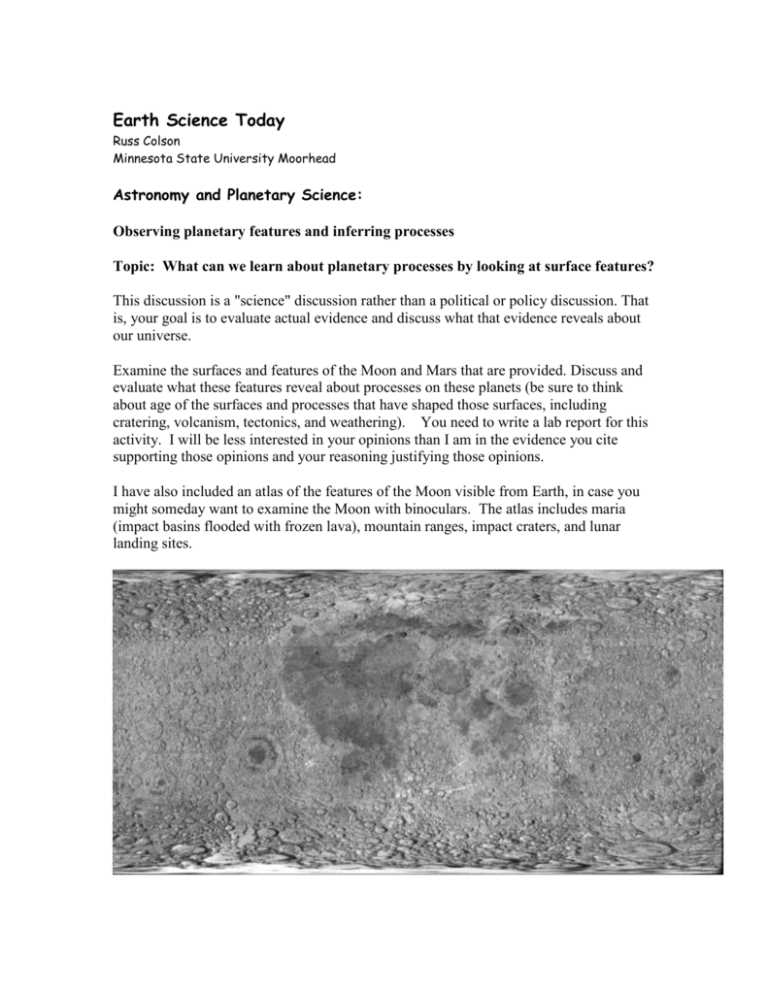
Earth Science Today Russ Colson Minnesota State University Moorhead Astronomy and Planetary Science: Observing planetary features and inferring processes Topic: What can we learn about planetary processes by looking at surface features? This discussion is a "science" discussion rather than a political or policy discussion. That is, your goal is to evaluate actual evidence and discuss what that evidence reveals about our universe. Examine the surfaces and features of the Moon and Mars that are provided. Discuss and evaluate what these features reveal about processes on these planets (be sure to think about age of the surfaces and processes that have shaped those surfaces, including cratering, volcanism, tectonics, and weathering). You need to write a lab report for this activity. I will be less interested in your opinions than I am in the evidence you cite supporting those opinions and your reasoning justifying those opinions. I have also included an atlas of the features of the Moon visible from Earth, in case you might someday want to examine the Moon with binoculars. The atlas includes maria (impact basins flooded with frozen lava), mountain ranges, impact craters, and lunar landing sites. Projection of Moon surface (Map) based on images from the Clementine mission. (craters toward poles appear bigger due to the projection expanding the smaller polar areas to make a rectangle out of a spherical planet.) View of Mars Mars from orbit Viking 1 Lander view Mars lander view . Atlas of features visible with the naked eye or binoculars on the Near Side of the Moon credit: www.arval.org.ve/MoonMapen.htm Maria: North: 1- Mare Frigoris (Sea of Cold) 2- Mare Imbrium (Sea of Rains) 3- Sinus Aestuum (Bay of Seething) Northeast: 4- Sinus Medii (Bay of the Center) 5- Mare Vaporum (Sea of Vapors) 6- Mare Serenitatis (Sea of Serenity) 7- Mare Tranquillitatis (Sea of Tranquillity) 8- Mare Crisium (Sea of Crises) 17- Lacus Somniorum (Lake of Sleep) 18- Palus Somnii (Marsh of Sleep) 19- Mare Anguis (Sea of Snakes) 20- Mare Undarum (Sea of Waves) Southeast: 9- Mare Fecunditatis (Sea of Fecundity) 10- Mare Nectaris (Sea of Nectar) 21- Mare Spumans (Sea of Foam) Southwest: 11- Mare Nubium (Sea of Clouds) 12- Mare Humorum (Sea of Moisture) 13- Mare Cognitum (Known Sea) 22- Palus Epidemiarum (Marsh of Diseases) West: 14- Oceanus Procellarum (Ocean of Storms) Northwest: 15- Sinus Roris (Bay of Dew) 16- Sinus Iridum (Bay of Rainbows) Montes (Mountains): Northeast: 23- Montes Alpes 24- Vallis Alpes (Alpine Valley) 25- Montes Caucasus 26- Montes Apenninus 27- Montes Haemus 28- Montes Taurus Southeast: 29- Montes Pyrenaeus Southwest: 30- Rupes Recta (Straight Wall) 31- Montes Riphaeus Northwest: 32- Vallis Schröteri (Schröter's Valley) [Northwest of Crater Aristarchus, 73, and North of Crater Erodotus] 33- Montes Jura Craters: Northeast: 34- Crater Aristotle [on the East part of Mare Frigoris, 1] 35- Crater Cassini 36- Crater Eudoxus 37- Crater Endymion 38- Crater Hercules 39- Crater Atlas 40- Crater Mercurius 41- Crater Posidonius 42- Crater Zeno 43- Crater Le Monnier 44- Crater Plinius 45- Crater Vitruvius 46- Cráter Cleomedes 47- Crater Taruntius 48- Crater Manilius 49- Crater Archimedes 50- Crater Autolycus 51- Crater Aristillus Southeast: 52- Crater Langrenus 53- Crater Goclenius 54- Crater Hypatia 55- Crater Theophilus 56- Crater Rhaeticus 57- Crater Stevinus 58- Crater Ptolemaeus 59- Crater Walter Southwest: 60- Crater Tycho 61- Crater Pitatus 62- Crater Schickard 63- Crater Campanus 64- Crater Bulliadus 65- Crater Fra Mauro 66- Crater Gassendi 67- Crater Byrgius 68- Crater Billy [Mons Hansteen is to the North of Crater Billy] 69- Crater Crüger 70- Crater Grimaldi 71- Crater Riccioli Northwest: 72- Crater Kepler 73- Crater Aristarchus [Crater Herodotus is West of Crater Aristarchus] 74- Crater Copernicus 75- Crater Pytheas 76- Crater Eratosthenes [near the Southwestern extreme of Montes Apenninus, 26] 77- Crater Mairan 78- Crater Timocharis 79- Crater Harpalus [Crater Pythagoras is North of Crater Harpalus] 80- Crater Plato Manned Missions: -- - Apollo 11 (July 20 '69) [Southwestern extreme of Mare Tranquilitatis, 7] -- - Apollo 12 (November 19 '69) [Northern extreme of Mare Cognitum, 13] -- - Apollo 13 (April 13 '70) [could not land North of Crater Fra Mauro, 65] -- - Apollo 14 (February 5 '71) [North of Crater Fra Mauro, 65] -- - Apollo 15 (July 31 '71) [Northern extreme of Montes Apenninus, 26] -- - Apollo 16 (April 21 '72) [between Craters Theophilus and Hipparchus, 55 and 56] -- - Apollo 17 (December 11 '72) [Southern extreme of Montes Taurus, 28] Notes: The directions East (E) and West (W) marked on the graphic, are directions as seen from the Moon; These are opposite of East and West as seen from the Earth

